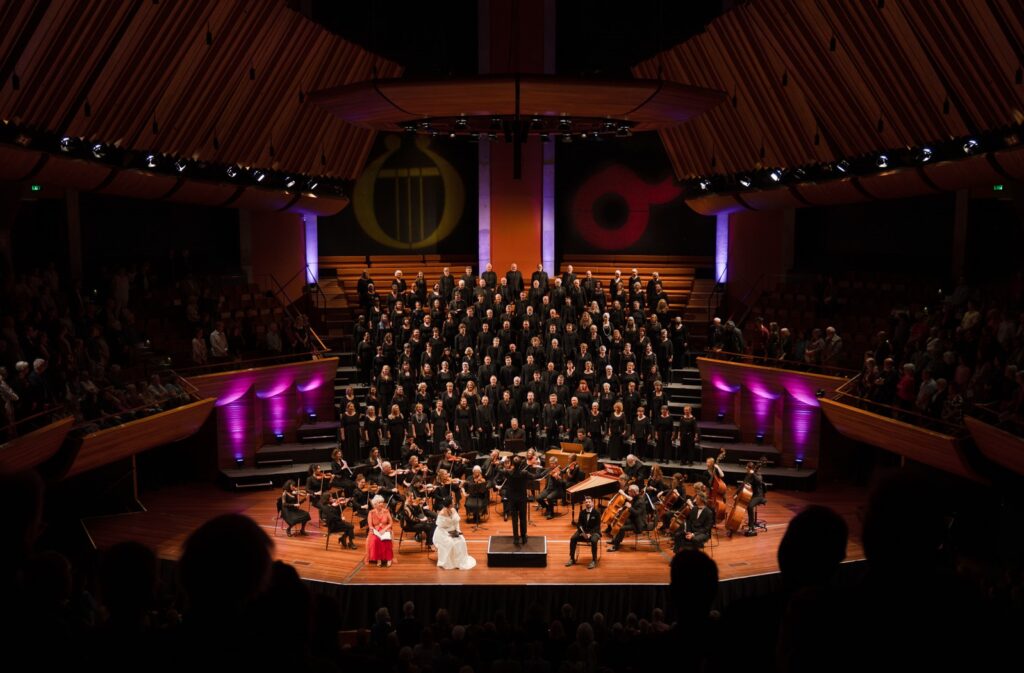JOSEPH HAYDN – The Creation
Anna Leese (soprano), Frederick Jones (tenor), Joel Amosa (bass-baritone)
Orpheus Choir of Wellington
Orchestra Wellington
Brent Stewart (conductor)
with Airu Matsuda/Jemima Smith (dancers)
Michael Fowler Centre, Wellington
Saturday, 24th August, 2024
Haydn’s “The Creation” seems to be on the “short list” of anybody’s compendium of great choral music experiences, but it was something that had, purely by accident, evaded me over the years. This of course necessitated on my part some urgently-driven and intensely-constituted preparatory experience of the work prior to my attending the Orpheus Choir’s and Orchestra Wellington’s eagerly-awaited Wellington performance.
My plan was to listen to several highly-regarded recordings, thinking I would get a well-rounded view of it all, though I confess to taking little notice of the circumstance that all of these performances presented the work in German even though I do remember reading about the fascinating peregrinations of the original anonymously-written English libretto that came into Haydn’s hands while in England. He then took it back to Austria and turned it over to Gottfried van Swieten, who translated it into German for Haydn to set to music, van Swieten also recasting the English words to “fit” with the composer’s work. It was one of the first works up to that time published with a libretto in two languages.
Having digested all of this, and feeling by the end of my listening that my surroundings and person-prototype had been suitably, not to say systematically reconstructed by the composer with the aid of an anonymous libretto drawn from Genesis, the Book of Psalms and John Milton, I felt more than ready for some ”live action”, as popular advertising would have it! And I was, of course, further intrigued by the publicity accompanying the Orpheus Choir’s 2024 presentation, with its promise of “stunning special effects” including a cinematic LED screen adding sight to sound, and dancers from Footnote New Zealand choreographing parts of the music-making! Obviously something special was afoot!
Adding “special effects” to live music-making in general is nothing new of late, and not even in the case of the classics, where, in performances of music traditionally presenting the notes of the score alone, there’s been a world-wide interest in augmenting such activities with just the kinds of things we were given this evening. Even certain works whose essential gravitas seemed to require a pure and unadorned approach have been given extra “componentry” in that it’s more than just the “sound” of the music that’s presented – Bach’s St.John Passion has , for example, been presented with dance choreography at this year’s prestigious Salzburg Festival.
These initiatives of course come with the best of intentions, with purposes most persuasively put – to quote the words of one entrepreneur: “Interractive concert technologies have introduced exciting ways to engage audiences during live performances. From synchronised light shows and projection mapping to mobile apps that enable audience participation, these technologies create a multisensory experience, blurring the boundaries between performers and spectators and fostering a deeper connection between the music and the audience.” A frequently recurring theme in these philosophies is the perceived “conservatism” and “exclusivity” of classical music as a barrier that needs to be broken down – as one event director put it, “….trying to make the music less intimidating and exclusive to people who can’t identify with the conservative, exclusionary image that classical music often has.”
Something that routinely divides audiences at performances with these “special effects” is the difference in attitude between age-groups. Those I talked with on Saturday night after the “Creation” performance included younger people who in general enjoyed the screened images and the dancers, and older people who mostly found them distracting and even annoying. For myself (these days a paid-up member of the grey-haired brigade!) I found parts of the screened imagery appropriately theatrical and dramatic (the contrast between the opening “void” with its convoluted and claustrophobic imagery and its sudden, dramatic, near-blinding light at the choir’s words “and there was LIGHT!!!” was stunning in its effect, for example, as was the ”sunrise/moonrise” imagery accompanying some of the beautiful concluding music of Part One). However as scene followed subsequent scene I found myself wondering what we were expected to be most engaged with – was it the music or the accompanying images? Under such circumstances I felt the most important consideration was a question of a proper synthesis between the two – and for me there seemed a significant proportion of the visual throughout the evening whose “busyness” was more of a distraction than the interactive motivation which the music surely deserved. The “extra” detailing I enjoyed as much as the more focused visual depictions was the presence in Part Three of the two dancers, Airu Matsuda representing Adam and Jemima Smith depicting Eve, their movements always in what seemed like properly organic synchronisation with both the words and the music, and earning them well-deserved plaudits of their own at the end.
Turning to the music and its performance by the singers and orchestra is to encounter what I thought were the occasion’s most resplendent qualities – right from the dark-browed, brooding instrumental opening of the work followed by bass-baritone Joel Amosa’s entrance as the Archangel Raphael and his splendidly-weighted voice (making me catch my breath momentarily at the realisation that he was singing in English!), the sounds held us in a grip of wonderment and expectation! It made that moment of release of both the choir’s and orchestra’s tumultuous torrent of sound at the word “Light” all the more elemental in its power and joyous in its liberation! What better a beginning, I thought, to such a cosmic event!
If tenor Frederick Jones sounded at first slightly tentative during the opening of his aria “Now vanish before the holy beams”, his voice “broke through” with the description of Satan’s host’s defeat and consignment to “endless night”, with the Orpheus voices revelling in the writing’s energy and determination with their cries of “Despairing, cursing rage attends their rapid fall”. And his ringing tones splendidly capped off the orchestra’s depiction of the majestic sun and the beauteous moon to great effect. Even better was his performance in Part Two of the great aria “In native worth and honour clad”, one describing the creation of man and woman (the sequence appropriately accompanied by the famous Michelangelo Sistine Chapel depiction of God creating Adam – however clichéd the image, it had for me that interactive “rightness” that made its proper mark).
Soprano Anna Leese’s brightly-focused voice made the perfect contrast to Joel Amosa’s splendid recitative “And God made the Firmament” when she undertook the celebratory “The marvellous work” with the choir again matching the soloist’s exuberant mood, Leese returning in more lyrical fashion for a bewitching “With verdue clad”, to which the orchestral winds added evocative detail that heightened the “ravish’d sense” of the beholder. As befitted the extra dynamism of living creatures, the soprano’s “On mighty pens” paid both sprightly and lyrical homage to the birds of the air, specifically the eagle, lark, dove and nightingale, the visuals “treating us” however vicariously and distractedly, to a simulated ride on the back of an eagle during this section! – though Anna Leese’s voice did manage to refocus our attentions on the music for some of the time, and garner sufficient appreciation for a lovely performance!
Of course the duet sequences of Part Three between the first man and woman, Adam and Eve, are always a highlight of this work – and here we were charmed by the interaction between the pair, firstly by the aforementioned dancers’ sequences which I thought of a piece with the whole in terms their simply-adorned and dream-like quality of expression; and then with the re-entrance of Anna Leese as Eve and Joel Amosa as Adam dressed almost as if for a wedding, which of course their union symbolizes in an archetypal sense. Even the tenor took part in the ritual’s beginning, introducing the pair in the most mellifluous of tones “In rosy mantle now appears”, a lovely piece of singing by Frederick Jones! It’s the precursor of a series of duets and declamations heart-warming in their effect, be it the pair’s alternating praise of and delight in the newly-created world (“Of stars the fairest”) or each one’s heartfelt declaration of love for the other during the course of “Our duty we have now performed”, both singers conveying a real sense of wonderment at their “coming into being” in a new world and sharing their rapturous excitement.
In attendance with all of this, and in places leading the way was the wonderful Orpheus Choir – music director Brent Stewart must have been well-and-truly stoked with his voices’ response to the composer’s every storytelling excitement, rhapsodic description and grandly resplendent moment, through all of which the choir never faltered. To single out any particularly memorable moment (which I’ve done already!) would be to underplay the totality of the Orpheus’s achievement in conveying Haydn’s sheer inventiveness and flexibility. Right with the choir for every demisemiquaver of the journey was Orchestra Wellington, whose recent appearances in a punishing schedule of concerts had already confirmed its reputation as a brilliant and formidable ensemble – here, enhanced even further.
While the effectiveness of much of the “reimagined” aspect of the presentation will remain a matter of taste and opinion, there can be no doubt as to the stellar musical qualities of the occasion thanks to all concerned, conductor, soloists, choir and orchestra! To quote wholeheartedly from the libretto itself – “Achieved is the glorious work!”
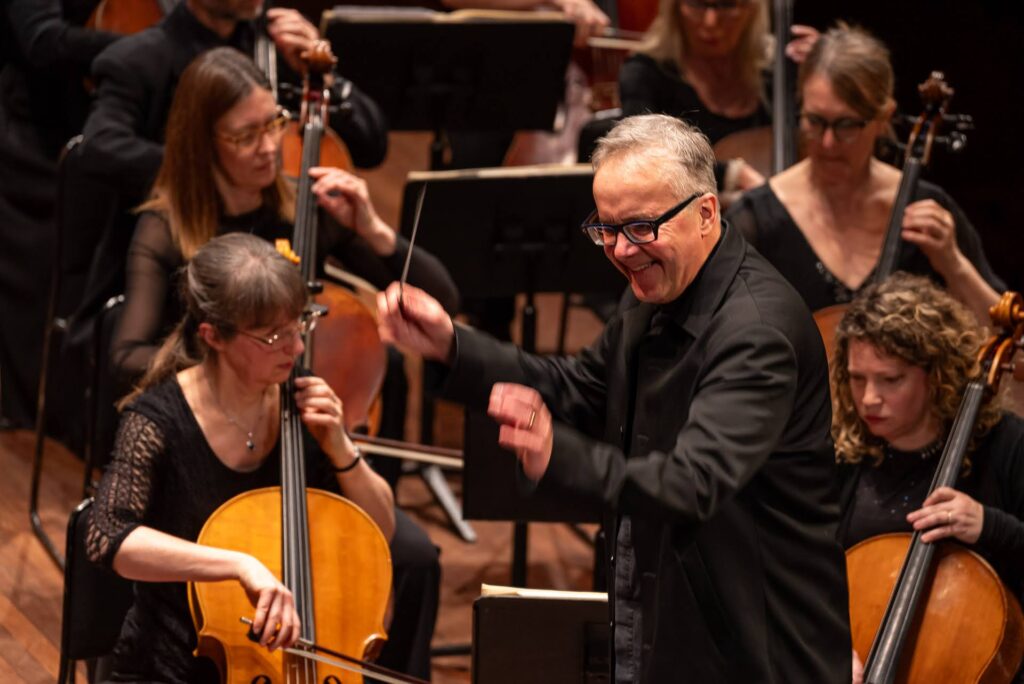 Orchestra Wellington Music Director, Marc Taddei – photo credit: Latitude Creative
Orchestra Wellington Music Director, Marc Taddei – photo credit: Latitude Creative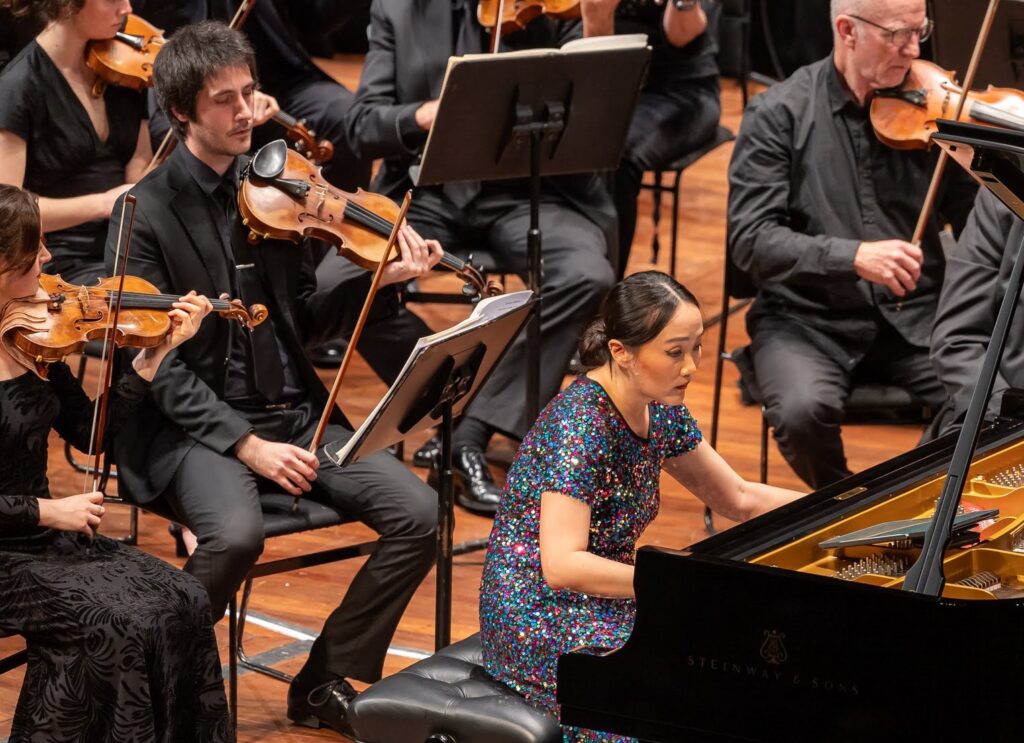 Somi Kim, piano, plays Germaine Tailleferre’s 1924 Piano Concerto with Orchestra Wellington – photo credit: Latitude Creative
Somi Kim, piano, plays Germaine Tailleferre’s 1924 Piano Concerto with Orchestra Wellington – photo credit: Latitude Creative Soloists Emma Pearson (soprano), Margaret Medlyn, (mezzo-soprano), Emmanuel Fonoti-Fuimaono (tenor) and Robert Tucker (baritone), with the Orpheus Choir of Wellington, Orchestra Wellington, and Music Director Marc Taddei – Photo credit: Latitude Creative
Soloists Emma Pearson (soprano), Margaret Medlyn, (mezzo-soprano), Emmanuel Fonoti-Fuimaono (tenor) and Robert Tucker (baritone), with the Orpheus Choir of Wellington, Orchestra Wellington, and Music Director Marc Taddei – Photo credit: Latitude Creative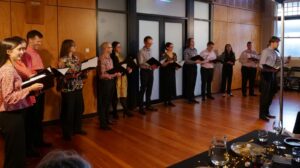 Director Michael Stewart in front of The Tudor Consort
Director Michael Stewart in front of The Tudor Consort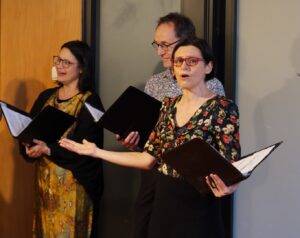 From left: Alexandra Granville, Keith Small, Rebecca Stanton (in front).
From left: Alexandra Granville, Keith Small, Rebecca Stanton (in front).